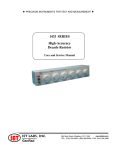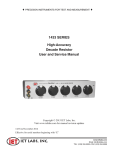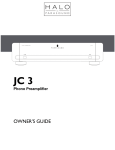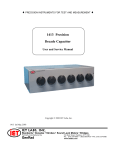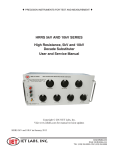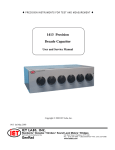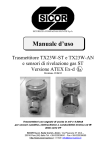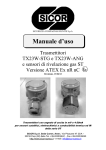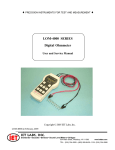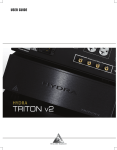Download 1433 SerieS High-Accuracy Decade resistor User and Service Manual
Transcript
♦ PRECISION INSTRUMENTS FOR TEST AND MEASUREMENT ♦ 1433 Series High-Accuracy Decade Resistor User and Service Manual Copyright © 2009 IET Labs, Inc. Visit www.ietlabs.com for manual revision updates 1433 im/May 2009 IET LABS, INC. 534 Main Street, Westbury, NY 11590 www.ietlabs.com TEL: (516) 334-5959 • (800) 899-8438 • FAX: (516) 334-5988 ♦ PRECISION INSTRUMENTS FOR TEST AND MEASUREMENT ♦ IET LABS, INC. 534 Main Street, Westbury, NY 11590 www.ietlabs.com TEL: (516) 334-5959 • (800) 899-8438 • FAX: (516) 334-5988 WArrANTY We warrant that this product is free from defects in material and workmanship and, when properly used, will perform in accordance with applicable IET specifications. If within one year after original shipment, it is found not to meet this standard, it will be repaired or, at the option of IET, replaced at no charge when returned to IET. Changes in this product not approved by IET or application of voltages or currents greater than those allowed by the specifications shall void this warranty. IET shall not be liable for any indirect, special, or consequential damages, even if notice has been given to the possibility of such damages. THIS WARRANTY IS IN LIEU OF ALL OTHER WARRANTIES, EXPRESSED OR IMPLIED, INCLUDING BUT NOT LIMITED TO, ANY IMPLIED WARRANTY OF MERCHANTIBILITY OR FITNESS FOR ANY PARTICULAR PURPOSE. WArNiNG OBSERVE ALL SAFETY RULES WHEN WORKING WITH HIGH VOLTAGES OR LINE VOLTAGES. Dangerous voltages may be present inside this instrument. Do not open the case Refer servicing to qulified personnel HIGH VOLTAGES MAY BE PRESENT AT THE TERMINALS OF THIS INSTRUMENT WHENEVER HAZARDOUS VOLTAGES (> 45 V) ARE USED, TAKE ALL MEASURES TO AVOID ACCIDENTAL CONTACT WITH ANY LIVE COMPONENTS. USE MAXIMUM INSULATION AND MINIMIZE THE USE OF BARE CONDUCTORS WHEN USING THIS INSTRUMENT. Use extreme caution when working with bare conductors or bus bars. WHEN WORKING WITH HIGH VOLTAGES, POST WARNING SIGNS AND KEEP UNREQUIRED PERSONNEL SAFELY AWAY. CAUTiON DO NOT APPLY ANY VOLTAGES OR CURRENTS TO THE TERMINALS OF THIS INSTRUMENT IN EXCESS OF THE MAXIMUM LIMITS INDICATED ON THE FRONT PANEL OR THE OPERATING GUIDE LABEL. Contents Chapter 1: INTRODUCTION........................................................................1 1.1 Product Overview..................................................................................................... 1 1.2 Accessories Included................................................................................................ 2 1.3 Accessories/Options Available.................................................................................. 2 Chapter 2: SPECIFICATIONS.....................................................................3 Chapter 3: OPERATION..............................................................................5 3.1 Initial Inspection and Setup...................................................................................... 5 3.2 Connection................................................................................................................ 5 3.2.1 General Considerations................................................................................... 5 3.2.2 Electrical Considerations................................................................................ 5 3.2.3 Four-Wire Kelvin Lead Connections.............................................................. 5 3.2.4 Thermal emf Considerations........................................................................... 6 3.3 Dial Setting............................................................................................................... 6 3.4 Principles of Operation............................................................................................. 6 Chapter 4: MAINTENANCE.........................................................................8 4.1 Verification of Performance...................................................................................... 8 4.1.1 Preventive Maintenance.................................................................................. 8 4.1.2 Calibration Interval......................................................................................... 8 4.1.3 General Considerations................................................................................... 8 4.1.4 Calibration Procedure..................................................................................... 9 4.2 Schematic.................................................................................................................. 9 4.3 Replaceable Parts List............................................................................................... 10 Tables and Figures Figure 1.1: 1433 Series High-Accuracy Decade Resistor.............................1 Figure 3.1: Optimal 4-Wire Kelvin Lead Connection.....................................6 Figure 3-2: A simplified equivalent circuit for a decade box with the low (L) terminal tied to case..............................................................................................6 Figure 3-3: Equivalent three terminal circuit for a decade box with neither terminal tied to case..............................................................................................7 Figure 3-4: Approximation of distributed capacitance effects........................7 Figure 4.1: 1433 Series Schematic Diagram................................................9 Table 4.2: Replacement List..........................................................................10 Figure 4.2: 1433 Replaceable Parts..............................................................10 1433 Series Chapter 1 INTRODUCTION 1.1 Product Overview The 1433 Decade Resistors are a family of instruments providing a very broad choice of high-performance resistance sources. Any number of decades from one to eleven is available. The 1433 is a precision resistance source with excellent characteristics of stability, temperature coefficient, power coefficient, and frequency response. There are over 30 models available covering a wide resistance range from 1 mΩ to over 111 MΩ. The 1433 Series employs stable, very-low-resistance switches with silver-alloy contacts. A special design keeps zero-resistance to less than 1 mΩ per decade. Self-cleaning keeps the silver contacts from becoming tarnished when unused, or when only low currents are passed through them. This is most often the case when only minute test currents are drawn by digital multimeters or other test instruments. Contact resistance is stable and remains low and repeatable. The dials, labeled 0 to X(=10), offer smooth rotation from position to position with no stops. Each dial has an overlap X(10) position for maximum convenience and flexibility in setting and adjusting resistance values. The resistance per step and maximum current of each dial are clearly shown on the front panel. Electrical shielding is provided by an attractive aluminum cabinet and front panel. The resistance elements have no electrical connection to the cabinet and panel; a separate shield terminal is provided. All other conductors within the instrument, as well as the solder employed, contain no metals or junctions that contribute to thermal emf problems. With a resolution as low as 1 mΩ and a maximum available resistance of over 111 MΩ, the 1433 series may be used for exacting precision measurement applications requiring high accuracy, good stability, and low zero-resistance. They can be used as components of dc and ac bridges, for calibration, as transfer standards, and as RTD simulators. The 1433 Series may be rack-mounted to serve as components in measurement and control systems. This series is part of a family of resistance substituters suited to fill many engineering and testing needs. Consult IET for: High-power substituters - up to > 400 W High-resistance substituters - to 1 TΩ RTD simulators Laboratory-standard-grade substituters - to 1 ppm accuracy Programmable substituters - IEEE-488 or BCD. Figure 1.1: 1433 Series High Accuracy Decade Resistor High-quality gold-plated tellurium-copper binding posts serve to minimize the thermal emf effects which can introduce errors into dc resistance measurements. Introduction 1 1433 Series This page is intentionally left blank. 2 Introduction 1433 Series Chapter 2 SPECIFICATIONS For the convenience of the user, the pertinent specifications are given in an OPERATING GUIDE affixed to the case of the instrument. Range: 1 mΩ to 111.111.111.110 Ω in 1 mΩ steps. Overall Accuracy: The difference between the resistance at any setting and at the Zero setting is equal to the indicated value ± (0.01% + 2 mΩ) Decade Specifications Resistance per Step Total Decade Resistance Stability (±ppm/year) L/step (µH) normal Max Input Power/step (W) Temperature Coefficient (±ppm/°C) 1 mΩ 10 mΩ 100 - 5A 0.025 50 20 10 mΩ 100 mΩ 50 0.01 4A 0.16 100 mΩ 1Ω 30 0.1 1.6 A 0.25 20 1Ω 10 Ω 20 0.15 800 mA 0.6 20 10 Ω 100 Ω 20 0.55 250 mA 0.6 15 100 Ω 1 kΩ 20 5 80 mA 0.6 5 1 kΩ 10 kΩ 20 15 23 mA 0.5 5 10 kΩ 100 kΩ 20 75 7 mA 0.5 5 100 kΩ 1 MΩ 20 - 2.3 mA 0.5 5 1 MΩ 10 MΩ 20 - 0.7 mA 0.5 10 10 MΩ 100 MΩ 50 - 0.23 mA 0.1 10 Typical Frequency Characteristics: Specifications 3 1433 Series Typical Value of Zero Impedance: Zero Resistance (Ro): 0.001 Ω/decade at dc; 0.04 Ω/decade at 1 MHz; proportional to square root of frequency above 100 kHz. Zero Inductance (Lo): 0. 1 µH/decade + 0.2 µH. Effective Shunt Capacitance (C): Value is determined largely by the highest decade in use. With the low terminal connected to the shield, a value of 15 to 20 pF/decade may be assumed, counting decades down from the highest. Thus, if the third decade from the top is the highest resistance, a value of 45 to 60 pF may be assumed. If the highest decade in the unit is in use, the effective capacitance is 15 to 20 pF, regardless of the settings of the lower-resistance decades. Switches: Continuous rotation; solid silver-alloy contacts; contact resistance of less than 1 mΩ; capacitance of less than 1 pF between contacts; lifetime in excess of 1 million cycles. Maximum voltage to case: 2000 V peak Terminals: Gold-plated, tellurium-copper, low-thermal-emf binding posts on standard 3/4 inch spacing; shield terminal provided. Ordering Information: Catalog No. 1433-01 1433-00 1433-02 1433-04 1433-06 1433-08 1433-09 1433-09A 1433-10 1433-12 1433-14 1433-16 1433-18 1433-18A 1433-19 1433-20 1433-22 1433-24 1433-26 1433-27 1433-28 1433-29 1433-31 1433-33 1433-34 1433-35 1433-36 1433-37 1433-38 1433-39 1433-39A 1433-39B 1433-40A 1433-40 1433-41 Mechanical: Model 3-5 decade Dimensions 37.5 cm W x 8.9 cm H x 10.2 cm D (14.75" x 3.5" x 4") 6 decades 43.9 cm W x 8.9 cm H x 10.2 cm D 7 decades (17.3" x 3.5" x 4") 8 decades Weight 2.0 kg (4.3 lb) 2.2 kg (4.8 lb) 2.4 kg (5.3 lb) 3.4 kg (7.5 lb) 9 decades 48.3 cm W x 17.8 cm H x 17.8 cm D 3.5 kg (7.7 lb) 10 decades (19" x 7" x 7") 3.6 kg (7.9 lb) 11 decades Ohms /step 0.001 0.01 0.1 1 10 100 1000 10,000 0.01 0.1 1 10 100 1000 0.001 0.01 0.1 1 10 100 0.001 0.01 0.1 1 10 0.001 0.01 0.1 1 0.001 0.01 0.1 0.001 0.01 0.001 No. of dials 3 4 4 4 4 4 4 4 5 5 5 5 5 5 6 6 6 6 6 6 7 7 7 7 7 8 8 8 8 9 9 9 10 10 11 3.7 kg (8.1 lb) Environmental: Operating: +10 to +40oC, <80% RH Storage: -20 to +65oC Supplied with unit: Instruction manual Calibration Certificate 4 Total (Ω) 1.11 111.1 1,111 11,110 111,100 1,111,000 11,110,000 111,100,000 1,111.1 11,111 111,110 1,111,100 11,111,000 111,110,000 1,111.11 11,111.1 111,111 1,111,110 11,111,100 111,111,000 11,111.11 111,111.1 1,111,111 11,111,110 111,111,100 111,111.110 1,111,111.10 11,111,111.0 111,111,110 1,111,111.11 11,111,111.1 111,111,111 11,111,111,110 111,111,111.1 111,111,111.11 Options: • RO Rear output binding posts • RM Rack-mountable case for standard 19” rack Specifications 1433 Series Chapter 3 OPERATION 3.1 Initial Inspection and Setup 3.2.2 Electrical Considerations This instrument was carefully inspected before shipment. It should be in proper electrical and mechanical order upon receipt. In order to make proper use of the full performance capabilities of the 1433 unit, especially if low resistance or low-resistance increments are important, take care when connecting to the terminals of the decade box. In particular, in order to keep contact resistance to a minimum, take the most substantial and secure connection to the binding posts. They accept banana plugs, telephone tips, spade lugs, alligator clips, and bare wire. The largest or heaviest mating connection should be made, and, where applicable, the binding posts should be securely tightened. An OPERATING GUIDE is attached to the case of the instrument to provide ready reference to specifications. 3.2 Connection 3.2.1 General Considerations The 1433 Series Decade unit provides three terminals labeled H (high), L (low), and G (ground). The H and L terminals are connected to the set resistance; the G terminal is connected to the case. The G terminal may be used as a guard or shield terminal. It may also be connected (using a shorting link) to the L terminal to allow two-terminal as opposed to three-terminal measurements. In order to make the most stable measurements, determine which is the more sensitive of the two user leads, i.e. the one going into a higher impedance. This lead should be connected to the more protected one of the two 1433 terminals. That would either be the 1433 terminal that is shorted to the case, or the LOW 1433 terminal whenever neither is connected to the case. These considerations may be relaxed whenever single milliohms are considered insignificant for the task being performed. 3.2.3 Four-Wire Kelvin Lead Connections Whenever possible, 4-wire Kelvin leads, the ideal connection, should be employed. Such a connection minimizes the effects of contact resistance and approaches ideal performance. If the four terminals are available as clamps similar to alligator clips, they may be connected to the necks of the binding posts. If the four terminals are available separately, the optimal connection is shown in Figure 3.1, where the current leads are introduced into the top of the binding posts, and the voltage leads at the necks. If switches have not been operated for an extended period, they should be rotated a few times to assure that contact resistance is within specifications. Operation 5 1433 Series and a setting of 10-10-10-l0-10.10 Ω becomes: 10 1 0 0 0 0 0.0 10 1 0 0 0 0.0 10 1 0 0 0.0 10 1 0 0.0 10 1 0.0 .10 1.0 ____________________________ TOT 1 1 1 1 1 1.0 Figure 3.1: Optimal 4-Wire Kelvin Lead Connection 3.2.4 Thermal emf Considerations The highest-quality low-emf components are used in the 1433 Series. There nevertheless may be some minute thermal emf generated at the test leads where they contact the gold-plated binding posts. This emf will not manifest itself if an ac measurement instrument is employed. It will also be eliminated if a meter with a “True Ohm” capability is used. Otherwise it may appear as a false component of the dc resistance measurement. It is also possible to take a second measurement with the leads reversed and average the readings. 3.3 Dial Setting Whenever the dials are used in positions 0-9, the resulting resistance is read directly. Both the decimal point and the steps are clearly marked on the panel. For additional flexibility and range, each decade provides a “10” position setting. This “10” position on any one decade equals the “1” position on the next higher decade. It adds about 11% to the nominal total decade resistance. To determine the resistance obtained when one or more “10” settings are used, simply add “1” to the next higher decade. For example, a setting of 3-610-0-10 Ω becomes: 3 3 0 0 0 0 6 6 0 0 0 1 0 1 0 0 0 0 0 0 1 0 1 0 _ _ _ _ _ _ _ _ _ _ _ _ _ _ _ _ _ _ _ _ _ _ _ _ _ _ _ _ 6 TOT 3 7 0 1 0 3.4 Principles of Operation The best approximation of a complete equivalent circuit for a 1433 Decade Resistor is shown in Figure 3-2. Figure 3-2: A simplified equivalent circuit for a decade box with the low (L) terminal tied to case In Figure 3-2: R = setting of the decade box. L =LO= N1 ∆ L1 + N2 ∆ L2 + .... where Lo ≈ 0.1 µH per decade x number of decades in unit + 0.2 µH. ∆ L1, ∆ L2,....... ≈ L/step values from specifications. N1, N2,... ≈ settings of corresponding decades. C=Co+MC1 where CO≈ 15 pF C1≈ 20 pF M = number of unused decades (set to zero) preceding first decade used. The phase angle (Q) for this circuit is: Q≈ω(L/R - RC). At low values of R, the L/R term is dominant; at high values of R, the RC term is more important. The effective series resistance is: Operation 1433 Series Rs = R 1+ω2R2C2 The effective parallel resistance is: ω2 L2 Rp = R 1+ R2 ( ) At low values, the series resistance remains constant to rather high frequencies because inductance has no effect on Rs. At very low values, skin effect increases Rs. At high values, the series resistance falls off rather rapidly with frequency because of capacitance. The parallel resistance, however, is not affected by the lumped capacitance shown in the simple equivalent circuit (see Figure 3-2). The parallel value is affected by distributed capacitance and dielectric loss not shown. An approximate equation that considers these effects on Rp is: Rp ≈ R[1+ R = setting of the decade box. L = LO = N1 ∆L1 + N2 ∆L2+ .... where Lo ≈ 0.1 µH per decade x number of decades in unit + 0.2 µH. ∆ L1, ∆ L2, ... ≈ L/step values from specifications. N1, N2, ... ≈ settings of corresponding decades. Ca = l0 Ma + 8 pF where Ma = number of unused decades (set to zero) preceding first decade used. Cb = 20 Mb + 20 pF where Mb = number of unused decades (set to zero) preceding first decade used. Cs = 2 pF ω2 L2 - ωR10-3- 4ω2R210-24-25ω2RRy10-24] R2 The ωR10-13 term represents dielectric loss, the next term represents distributed capacitance in the first decade used (not zero), and the last term represents distributed capacitance in the first decade if it is not used (set to zero), where Ry is the total possible value of that decade. (The last term is not used if the first decade is not set to zero). When the case is not tied to either terminal, the decade resistor becomes a threeterminal circuit as shown in Figure 3-3. Figure 3-4: Approximation of distributed capacitance effects Figure 3-3: Equivalent three terminal circuit for a decade box with neither terminal tied to case There is also some distributed capacitance (Cd) from the resistor to the case, as shown in Figure 3-4. This capacitance has the effect of increasing the effective inductance by an amount of approximately N3R2C x 10-3: where N is the setting of the first used (not zero) decade, R is the total value of the decade resistor, and C is 2 pF. In Figure 3-3: Operation 7 1433 Series Chapter 4 MAINTENANCE 4.1 Preventative Maintenence 4.2 Calibration Interval Keep the unit in a clean environment. This will help prevent possible contamination. The recommended calibration interval for 1433 Series decade substituters is twelve (12) months. The calibration procedure may be carried out by the user if a calibration capability is available, by IET Labs, or by a certified calibration laboratory. If the user should choose to perform this procedure, then the considerations below should be observed. 1433 is packaged in a closed case, which limits the entry of contaminants and dust to the inside of the instrument. If it is maintained in a clean or airconditioned environment, cleaning will seldom be required. In a contaminated atmosphere, cleaning may be required. Should cleaning be needed, do the following: 1. Remove the 4 housing screws from the sides of the instrument, and remove the housing. 2. Remove any dust or debris using optical grade dry compressed air or a clean brush. 3. Should switch contact cleaning or lubrication be required, as may be indicated by an increase in the zero resistance, this may be done be spraying the switch contacts with a conditioning compound such as WD-40 or Deoxit from Caig Laboratories 4. Replace the housing and reinstall the 4 hous ing screws. The front panel should be periodically cleaned to eliminate any leakage paths around the binding posts. To clean the front panel, do the following: Wipe the front panel clean using alcohol and a lint-free cloth. 4.3 General Considerations It is important, whenever testing the 1433 Series Decade Units, to be very aware of the capabilities and limitations of the test instruments used. A resistance bridge may be employed, and there are direct-reading resistance meters or digital multimeters available that can verify the accuracy of these units, especially when used in conjunction with standards that can serve to confirm or improve the accuracy of the testing instrument Such test instruments must be significantly more accurate than ±(l00ppm+2 mΩ) for all applicable ranges, allowing for a band of uncertainty of the instrument itself. A number of commercial bridges and meters exist that can perform this task; consult IET Labs. It is important to allow both the testing instrument and the 1433 to stabilize for a number of hours at the nominal operating temperature of 23OC, and at nominal laboratory conditions of humidity. There should be no temperature gradients across the unit under test. Substantial Kelvin-type 4-wire test terminals should 8 Maintenance 1433 Series be used to obtain accurate low-resistance readings. It is convenient, once the zero resistance has been determined, to subtract it from the remaining measurements. This can be automatically done in many instruments which have an offset subtraction capability. 4.5 Schematic Refer to Figure 4.1 for a schematic of the 1433 decade unit. 4.4 Calibration Procedure 1. Determine the proper metrological practices. Allow a confidence band for the uncertainty of the measuring instrument and setup. 2. Confirm the zero resistance of the unit. 3. Determine the allowable upper and lower limits for each resistance setting of each decade based on the specified accuracy. For the 1433 series, these limits for any resistance “R” are [R±(0.0001 R + 2 mΩ)]. 4. Confirm that the resistances fall within these limits after subtraction of the zero resistance. 5. If any resistances fall outside these limits, the associated switch assembly may require trimming or replacement. Figure 4.1: 1433 Series Schematic Diagram 9 Maintenance 1433 Series 4.3 Replaceable Parts List Model Ref IET Pt No Description 1 01-1033-8-0312 Binding Post, Red 2 01-1033-8-0310 Binding Post, Black 3 01-1008-1-0310 Binding Post, Gold 4 1433-4300-KNB Knob Assembly Not Shown 1433-3100 Foot Not Shown 1433-4000-X-.001 1 mΩ/step Decade Switch Assembly Not Shown 1433-4000-X-0.01 10 mΩ/step Decade Switch Assembly Not Shown 1433-4000-X-0.1 100 mΩ/step Decade Switch Assembly Not Shown 1433-4000-X-1 1 Ω/step Decade Switch Assembly Not Shown 1433-4000-X-10 10 Ω/step Decade Switch Assembly Not Shown 1433-4000-X-100 100 Ω/step Decade Switch Assembly Not Shown 1433-4000-X-1k 1 kΩ/step Decade Switch Assembly Not Shown 1433-4000-X-10k 10 kΩ/step Decade Switch Assembly Not Shown 1433-4000-X-100k 100 kΩ/step Decade Switch Assembly Not Shown 1433-4000-X-1M 1 MΩ/step Decade Switch Assembly Not Shown 1433-4000-X-10M 10 MΩ/step Decade Switch Assembly Table 4.2: Replacement List 4 1 2 3 10 Figure 4.2: 1433 Replaceable Parts Maintenance


















